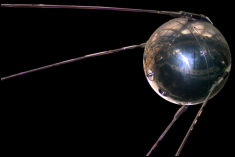 |

|
 |
History changed on October 4, 1957, when the Soviet Union successfully launched Sputnik I. |
|
On October 4, 1957, an intercontinental ballistic missile was launched from the steppes of Kazakhstan in the former Soviet Union. It did not carry a weapon, but nonetheless it sent a shockwave across the United States. In less than two hours after lift-off, a 23-inch, 184-pound steel sphere called Sputnik (translated as ?traveling companion of the Earth?) passed through the skies over the launch site, confirming that a man-made moon was now orbiting the Earth at approximately 17,000 miles per hour. The Space Age had begun. As news of the Soviet accomplishment quickly spread by radio and television, untold millions climbed onto rooftops, ventured into city parks, or ambled out to dark backyards, all scanning the heavens for a glimpse of a rapidly moving star. Shortwave radio operators picked up a persistent ?beep ? beep ? beep? signal broadcast from the satellite as it passed overhead.
The United States responded to Sputnik in several ways. School curriculums with an emphasis on science and mathematics were quickly established to prepare students for the challenges ahead; the National Defense Education Act was enacted to provide hundreds of millions of dollars in student loans, scholarships, fellowships, and the purchase of scientific equipment for schools; support was expanded for the National Science Foundation, and the Advanced Research Projects Agency was created. The shock of Sputnik was also largely responsible for the establishment of the National Aeronautics and Space Administration (NASA) in 1958 to conduct the United States' civilian space efforts. Thus, the United States and the Soviet Union began a duel for control of the heavens, the so-called "Space Race" that consumed both nations for the next decade.
Sputnik means satellite in Russian. It was shaped like a sphere and had four radiating radio antennae. Launched on October 4th, 1957, the world did not expect the Soviet Union to beat the technologically advanced USA with this Space First.
It functioned for 21 days. Its on-board radio transmitter sent out a beep beep signal that was heard all around the world. It was launched by the R-7 Rocket aka Vostok Rocket at Baikonour, Soviet Union. Today the modern derivative is called Soyuz Rocket.
Related Articles:
UMD to Lead Milestone NSF High School Engineering Pilot Course
Davis to Serve as Faculty Mentor for NSF-Funded Global STEWARDS Program
Aerospace Engineering Students and Alumni Receive NSF Fellowships
Shrestha Receives 2015 NSF Graduate Research Fellowship
Two Aero Students Awarded NSF Graduate Research Fellowships
Changing the Odds
Dr. Derek Paley Awarded NSF Grant
Sedwick Awarded 2009 NSF Career Award
October 1, 2007
|

